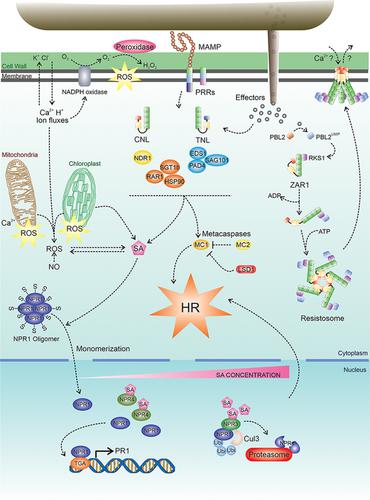当前位置:
X-MOL 学术
›
Ann. Appl. Biol.
›
论文详情
Our official English website, www.x-mol.net, welcomes your
feedback! (Note: you will need to create a separate account there.)
Hypersensitive response: From NLR pathogen recognition to cell death response
Annals of Applied Biology ( IF 2.2 ) Pub Date : 2020-10-16 , DOI: 10.1111/aab.12657 Ronaldo J. D. Dalio 1, 2 , Daniele Paschoal 3 , Gabriella D. Arena 1, 3, 4 , Diogo M. Magalhães 1, 2 , Tiago S. Oliveira 1 , Marcus V. Merfa 1 , Heros J. Maximo 1, 2 , Marcos A. Machado 1
Annals of Applied Biology ( IF 2.2 ) Pub Date : 2020-10-16 , DOI: 10.1111/aab.12657 Ronaldo J. D. Dalio 1, 2 , Daniele Paschoal 3 , Gabriella D. Arena 1, 3, 4 , Diogo M. Magalhães 1, 2 , Tiago S. Oliveira 1 , Marcus V. Merfa 1 , Heros J. Maximo 1, 2 , Marcos A. Machado 1
Affiliation

|
A wide range of potentially plant pathogenic microorganisms are naturally present in the environment. Despite relying only on the innate immune system, plants are able to resist most of the pathogens. Plants employ a multi‐layered defence system in which the first layer triggers the basal resistance (pathogen‐associated molecular pattern‐triggered immunity [PTI]). The second layer occurs when a resistance protein (R protein) that mostly encodes nucleotide‐binding leucine‐rich repeat receptors (NLRs) recognises an effector molecule secreted by an adapted pathogen, leading to effector‐triggered immunity (ETI), which triggers the hypersensitive response (HR). More recently, ETI was shown to restore and potentiate PTI signalling components, leading to a robust immune response. Multiple mechanisms of regulation are employed to guarantee proper HR activation. NLR proteins can interact between them and form a heel‐like pentamer that anchors to the plasma membrane. Furthermore, NLRs and other proteins can cooperate with NLRs to propagate the immune signalling. Downstream to the recognition of the pathogen by the plant, a rapid cellular response is initiated involving the generation of signalling events that precedes the HR. Here, we summarise the mechanisms involved in HR and highlight new advances in the knowledge of the immune system signalling. We also approach the role of HR threshold during infection by biotrophic, necrotrophic and hemibiotrophic pathogens and the impact in plant fitness and the community of pathogens found in the environment.
中文翻译:

过敏反应:从NLR病原体识别到细胞死亡反应
环境中自然存在多种潜在的植物致病微生物。尽管仅依赖先天免疫系统,但植物仍能够抵抗大多数病原体。植物采用多层防御系统,其中第一层触发基础抗性(病原体相关的分子模式触发的免疫[PTI])。第二层发生在主要编码富含核苷酸的亮氨酸重复序列受体(NLR)的抗性蛋白(R蛋白)识别出适应病原体分泌的效应子分子后,导致效应子触发的免疫(ETI),触发超敏反应回应(HR)。最近,ETI被证明可以恢复和增强PTI信号传导成分,从而导致强大的免疫反应。采用多种调节机制来保证适当的HR激活。NLR蛋白可以在它们之间相互作用,并形成锚定在质膜上的跟状五聚体。此外,NLR和其他蛋白质可与NLR协同传播免疫信号。在植物识别病原体的下游,启动了快速的细胞反应,涉及在HR之前发生信号事件。在这里,我们总结了参与HR的机制,并重点介绍了免疫系统信号传导知识方面的新进展。我们还探讨了HR阈值在生物营养性,坏死性和半生物营养性病原体感染过程中的作用,以及对植物适应性和在环境中发现的病原体群落的影响。NLR蛋白可以在它们之间相互作用,并形成锚定在质膜上的跟状五聚体。此外,NLR和其他蛋白质可与NLR协同传播免疫信号。在植物识别病原体的下游,启动了快速的细胞反应,涉及在HR之前发生信号事件。在这里,我们总结了参与HR的机制,并重点介绍了免疫系统信号传导知识方面的新进展。我们还探讨了HR阈值在生物营养性,坏死性和半生物营养性病原体感染期间的作用,以及对植物适应性和在环境中发现的病原体群落的影响。NLR蛋白可以在它们之间相互作用,并形成锚定在质膜上的跟状五聚体。此外,NLR和其他蛋白质可以与NLR协同传播免疫信号。在植物识别病原体的下游,启动了快速的细胞反应,涉及在HR之前发生信号事件。在这里,我们总结了参与HR的机制,并重点介绍了免疫系统信号传导知识方面的新进展。我们还探讨了HR阈值在生物营养性,坏死性和半生物营养性病原体感染过程中的作用,以及对植物适应性和在环境中发现的病原体群落的影响。在植物识别病原体的下游,启动了快速的细胞反应,涉及在HR之前发生信号事件。在这里,我们总结了参与HR的机制,并重点介绍了免疫系统信号传导知识方面的新进展。我们还探讨了HR阈值在生物营养性,坏死性和半生物营养性病原体感染过程中的作用,以及对植物适应性和在环境中发现的病原体群落的影响。在植物识别病原体的下游,启动了快速的细胞反应,涉及在HR之前发生信号事件。在这里,我们总结了参与HR的机制,并重点介绍了免疫系统信号传导知识方面的新进展。我们还探讨了HR阈值在生物营养性,坏死性和半生物营养性病原体感染过程中的作用,以及对植物适应性和在环境中发现的病原体群落的影响。
更新日期:2020-10-16
中文翻译:

过敏反应:从NLR病原体识别到细胞死亡反应
环境中自然存在多种潜在的植物致病微生物。尽管仅依赖先天免疫系统,但植物仍能够抵抗大多数病原体。植物采用多层防御系统,其中第一层触发基础抗性(病原体相关的分子模式触发的免疫[PTI])。第二层发生在主要编码富含核苷酸的亮氨酸重复序列受体(NLR)的抗性蛋白(R蛋白)识别出适应病原体分泌的效应子分子后,导致效应子触发的免疫(ETI),触发超敏反应回应(HR)。最近,ETI被证明可以恢复和增强PTI信号传导成分,从而导致强大的免疫反应。采用多种调节机制来保证适当的HR激活。NLR蛋白可以在它们之间相互作用,并形成锚定在质膜上的跟状五聚体。此外,NLR和其他蛋白质可与NLR协同传播免疫信号。在植物识别病原体的下游,启动了快速的细胞反应,涉及在HR之前发生信号事件。在这里,我们总结了参与HR的机制,并重点介绍了免疫系统信号传导知识方面的新进展。我们还探讨了HR阈值在生物营养性,坏死性和半生物营养性病原体感染过程中的作用,以及对植物适应性和在环境中发现的病原体群落的影响。NLR蛋白可以在它们之间相互作用,并形成锚定在质膜上的跟状五聚体。此外,NLR和其他蛋白质可与NLR协同传播免疫信号。在植物识别病原体的下游,启动了快速的细胞反应,涉及在HR之前发生信号事件。在这里,我们总结了参与HR的机制,并重点介绍了免疫系统信号传导知识方面的新进展。我们还探讨了HR阈值在生物营养性,坏死性和半生物营养性病原体感染期间的作用,以及对植物适应性和在环境中发现的病原体群落的影响。NLR蛋白可以在它们之间相互作用,并形成锚定在质膜上的跟状五聚体。此外,NLR和其他蛋白质可以与NLR协同传播免疫信号。在植物识别病原体的下游,启动了快速的细胞反应,涉及在HR之前发生信号事件。在这里,我们总结了参与HR的机制,并重点介绍了免疫系统信号传导知识方面的新进展。我们还探讨了HR阈值在生物营养性,坏死性和半生物营养性病原体感染过程中的作用,以及对植物适应性和在环境中发现的病原体群落的影响。在植物识别病原体的下游,启动了快速的细胞反应,涉及在HR之前发生信号事件。在这里,我们总结了参与HR的机制,并重点介绍了免疫系统信号传导知识方面的新进展。我们还探讨了HR阈值在生物营养性,坏死性和半生物营养性病原体感染过程中的作用,以及对植物适应性和在环境中发现的病原体群落的影响。在植物识别病原体的下游,启动了快速的细胞反应,涉及在HR之前发生信号事件。在这里,我们总结了参与HR的机制,并重点介绍了免疫系统信号传导知识方面的新进展。我们还探讨了HR阈值在生物营养性,坏死性和半生物营养性病原体感染过程中的作用,以及对植物适应性和在环境中发现的病原体群落的影响。











































 京公网安备 11010802027423号
京公网安备 11010802027423号